

The Snap CI Blog. Continuous delivery-with-maven. Creating a Redhat Yum Repository. Although many publically available yum repositories exist, creating one's own repository can result in better access and more control over the repository.

Yum or Apt? While aficionados will heatedly argue the advantages of one over the other, it basically does not matter whether you use yum or apt. What is critical, however, is that you stay up-to-date with one of these (or with Redhat's up2date server) in order to prevent security compromises. Historically, it seems that apt was initially more popular. However, yum has been incorporated into Fedora Core, the successor to Redhat Linux, and therefore may have overtaken apt in popularity. Overview. A Raspberry Pi Build Light for TeamCity in Mono. Some Background… After I bought my Raspberry Pi I went through a little period of uncertainty that most other owners have, asking myself “how do I make this thing useful?”
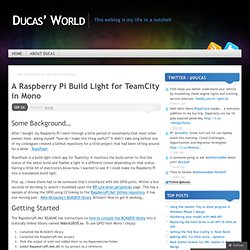
It didn’t take long before one of my colleagues created a GitHub repository for a little project that had been sitting around for a while – TeamFlash. TeamFlash is a build light client app for TeamCity. It monitors the build server to find the status of the latest build and flashes a light in a different colour depending on that status. Having a little bit of electronics know-how, I wanted to see if I could make my Raspberry Pi into a standalone build light.
First up, I knew there had to be someone that’s interfaced with the GPIO ports. Getting Started The RapsberryPi.Net README has instructions on how to compile the BCM2835 library into a statically linked library named libbcm2835.so. Now I can write code like: Running TeamFlash on YOUR Pi Here’s how you can get TeamFlash working on your Raspberry Pi. Ansible/ansible. Elastic Environments in Source-Control with Ansible. This is a group effort: Jefferson Girao helped me get the design right, and David McHoull and Deluan Quintao from our ThoughtWorks’ Toronto office worked through to an implementation.
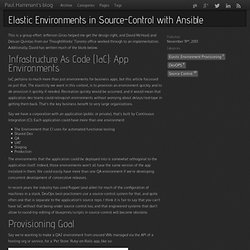
Additionally, David has written much of the blurb below. IaC pertains to much more than just environments for business apps, but this article focussed on just that. The elasticity we want in this context, is to provision an environment quickly and to de-provision it quickly if needed. Recreation quickly would be assumed, and it would mean that application dev teams could relinquish environments without worrying about delays/red-tape in getting them back. That’s the key business benefit to very large organizations. Escservesconfig - A webapp that provides configuration for applications that need to run in many environments.
You're developing an application.
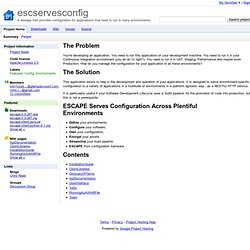
You need to run this application on your development machine. You need to run it in your Continuous Integration environment (you do do CI right?). You need to run it in UAT, Staging, Performance and maybe even Production. How do you manage the configuration for your application in all these environments? This application exists to help in the development and operation of your applications. Introducing ESCAPE. Whenever I talk to new clients about Continuous Integration, and especially about using Build Pipelines to extend their CI process to cover testing things like the deployment of their application, there is always one question that is guaranteed to pop up – how do I manage the configuration of my application in all these environments?
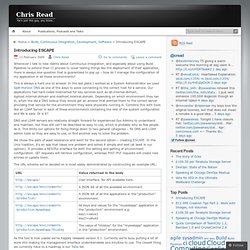
Ntinuous Delivery: Reliable Software Releases Through Build, Test, and Deployment Automation Addison-Wesley Signature: Amazon.co.uk: Jez Humble, David Farley: Books. Immutable Infrastructure with Ansible and Packer. At Codeship we run immutable servers which we internally call Checkbot.
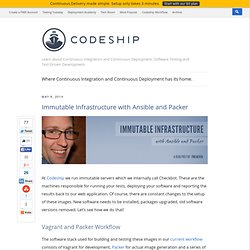
These are the machines responsible for running your tests, deploying your software and reporting the results back to our web application. Of course, there are constant changes to the setup of these images. New software needs to be installed, packages upgraded, old software versions removed. Let’s see how we do that! Vagrant and Packer Workflow The software stack used for building and testing these images in our current workflow consists of Vagrant for development, Packer for actual image generation and a series of shell scripts for provisioning.
Using Ansible Ansible with it’s YAML based syntax and agentless model fits quite nicely. How to deploy to Amazon OpsWorks using Codeship. This is a republished guest blog post by Edgars Lazdins.

He is director at Novo IT – a Web Development Agency from Latvia. You can find his original article here. Deploying code to Amazon OpsWorks using Codeship Here, at Novo IT, we love using Amazon OpsWorks for deploying our internal projects. With OpsWorks, we can easily segregate our development environments in Stacks and control how each project gets built via Chef recipes. One task, that is not immediately obvious how to solve, is triggering an OpsWorks build remotely from the command line, or from a build server.
Setting up a new IAM user on AWS We will make use of the AWS Identity and Access Management (IAM) feature to create a new user for our deployments. First, we go to IAM, click on Groups and then Create New Group. Creating a new AWS IAM group This group will provide all its members with access to OpsWorks. Select the AWS OpsWorks Full Access Policy. Is Simple IT Automation.